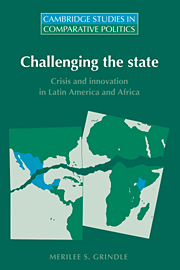Book contents
- Frontmatter
- Contents
- List of figures
- List of tables
- Acknowledgments
- 1 Challenging the state: a decade of crisis
- 2 Crisis and the state: evidence from Latin America and Africa
- 3 Crisis and breakdown in Mexico and Kenya
- 4 Imposing state authority
- 5 Managing the economy
- 6 Administering the public good
- 7 Responding to society
- 8 States of change
- Notes
- References
- Index
6 - Administering the public good
Published online by Cambridge University Press: 27 August 2009
- Frontmatter
- Contents
- List of figures
- List of tables
- Acknowledgments
- 1 Challenging the state: a decade of crisis
- 2 Crisis and the state: evidence from Latin America and Africa
- 3 Crisis and breakdown in Mexico and Kenya
- 4 Imposing state authority
- 5 Managing the economy
- 6 Administering the public good
- 7 Responding to society
- 8 States of change
- Notes
- References
- Index
Summary
In the early 1980s, as governments and international financial institutions struggled to manage deep economic problems, the immediate tasks of establishing macroeconomic stability and initiating the process of structural adjustment received almost exclusive attention. Soon, however, policy makers, practitioners, and development specialists began to question why many reforms did not produce expected results more quickly. As they asked this question, the issue of the administrative capacity of the state acquired greater salience.
Some policy reforms required long chains of administrative action if they were to be implemented – improved tax collection, customs reform, health sector restructuring, and decentralization of decision making, for example. Some required public officials to be active managers and problem solvers – deregulation, tariff reform, and privatization, for example. And the success of other reforms required procedures and institutional structures to facilitate market activities and to encourage risk taking by the private sector – the development of financial sector institutions and economic regulation, for example.
Initial adjustment efforts in Latin America and Africa confirmed that if government institutions were to monitor public spending, stimulate trade, expand the revenue base, manage an effective foreign exchange regime, and encourage private sector investment, they had to be organized effectively to carry out routine functions and they had to be able to count on administrators able to perform assigned tasks willingly, competently, and efficiently. The same realization applied even more to efforts to decentralize government to local and regional levels and encourage reforms in agriculture, health, and education.
- Type
- Chapter
- Information
- Challenging the StateCrisis and Innovation in Latin America and Africa, pp. 127 - 154Publisher: Cambridge University PressPrint publication year: 1996

